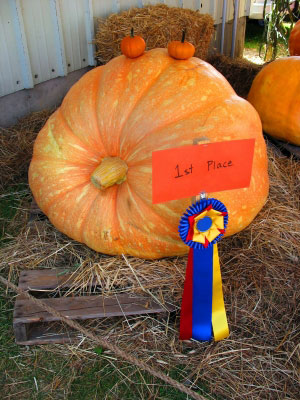Giant Pumpkin Breaks Record

The record for giant pumpkins was broken this month with one farmer growing a hefty gourd that weighed more than the average cow.
The record breaker, wider than the average human arm span, was grown in Jackson Township, Ohio and officially weighed in at 1,725 pounds at the Ohio Valley Giant Pumpkin Growers annual weigh-off earlier this month. The behemoth squash (of a variety of pumpkin called the Atlantic Giant) was grown by school teacher Christy Harp.
Harp said that she nursed her pumpkin to its whopping size by "pulling all the weeds and being out in the patch lots of hours," according to worldrecordsacademy.org.
Elsewhere, the nation's pumpkin crop is plentiful this year, though heavy rains and early frost could produce some regional shortages before Halloween.
Pumpkin weather
Pumpkins, which are thought to be native to North America, are a warm-weather crop, which means they grow best in the summer months with temperatures in the low to mid-80s (Fahrenheit), according to George Janowiak, president of the Illinois Pumpkin Growers Association.
Illinois, Indiana, Ohio, Pennsylvania, and California are the top pumpkin-producing states in the United States. The U.S. Department of Agriculture estimates that about 1.5 billion pounds of pumpkins are produced in the country each year. Estimates also show that pumpkin crops have been growing over the last couple of decades.
Get the world’s most fascinating discoveries delivered straight to your inbox.
Regionally, there have been some pumpkin problems this year.
An early frost in August killed off much of the Wisconsin, Janowiak said.
Another pumpkin killer is early-season heavy rain, which can soak a field and rot the seeds, Janowiak told LiveScience. The seeds must be replanted, which can leave a farmer under pressure to make the mid-fall harvest.
Unusually high rain amounts crippled many crops in New England this year, with Maine hit particularly hard. Some growers expected there to be local shortages.
But other areas, such as Illinois, the pumpkin-growing capital of the United States, have faired better this year.
Bigger and bigger
Most of the pumpkins grown for sale are much smaller than Harp's record-setter, of course. They're used to carve jack o' lanterns and make pumpkin pie. All pumpkins are from the family the family Cucurbitaceae. The giant variety that Harp and Janowiak grow is called Cucurbita maxima and were developed from more standard-sized stock by a man in Nova Scotia named Howard Dill in the early 1970s.
It took years to grow giant pumpkins to the size of Harp's, Janowiak said. But ever since the giant variety was created, "it just escalate[d] into trying to grow them bigger and bigger," he said.
Janowiak said that pumpkin supplies in Illinois are plentiful this year and while harvests in New England may suffer, Americans won't be facing a pumpkin shortage anytime soon.
- Halloween News & Information
- What Really Scares People: Top 10 Phobias
- Halloween's Top 10 Scary Creatures

Andrea Thompson is an associate editor at Scientific American, where she covers sustainability, energy and the environment. Prior to that, she was a senior writer covering climate science at Climate Central and a reporter and editor at Live Science, where she primarily covered Earth science and the environment. She holds a graduate degree in science health and environmental reporting from New York University, as well as a bachelor of science and and masters of science in atmospheric chemistry from the Georgia Institute of Technology.
 Live Science Plus
Live Science Plus





